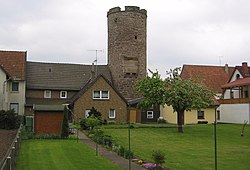Borgentreich
| Borgentreich | ||
|---|---|---|
 |
||
|
||
| Coordinates: 51°34′N 9°15′E / 51.567°N 9.250°ECoordinates: 51°34′N 9°15′E / 51.567°N 9.250°E | ||
| Country | Germany | |
| State | North Rhine-Westphalia | |
| Admin. region | Detmold | |
| District | Höxter | |
| Government | ||
| • Mayor | Rainer Rauch | |
| Area | ||
| • Total | 138.76 km2 (53.58 sq mi) | |
| Elevation | 169 - 371 m (−1,048 ft) | |
| Population (2015-12-31) | ||
| • Total | 9,497 | |
| • Density | 68/km2 (180/sq mi) | |
| Time zone | CET/CEST (UTC+1/+2) | |
| Postal codes | 34434 | |
| Dialling codes | 0 56 43 | |
| Vehicle registration | HX | |
| Website | www.borgentreich.de | |
Borgentreich is a municipality in Höxter district in North Rhine-Westphalia, Germany.
Borgentreich lies roughly 20 km south of Brakel and 10 km northeast of Warburg.
The constituent community of Borgholz lies on the foothill of a high ridge northeast of Borgentreich (main town).
Borgentreich consists of the following 12 centres:
Borgentreich was mentioned for the first time in 1280 under the name Borguntriche when Otto von Rietberg, the Bishop of Paderborn, was granted leave by Siegfried von Westerburg, the Archbishop of Cologne, to fortify the town.
Borgholz was first mentioned in 1291 in two documents, both confirming that there was a Borcholte at this time. It has to thank for its founding – as does the main town – a dispute over sovereignty in the area between the Archbishops of Cologne and the Bishops of Paderborn in the 13th century. The Archbishops of Cologne were trying to hem the Bishops' domain in with a ring of towns and castles.
The order to fortify the village high over the Jordan Valley was issued by Bishop Otto of Paderborn in 1290. He transferred to Bertold Schuwen a position as castle overseer (Burgmannsitz), the first one in the episcopal castle of Borgholz. A document of founding, or one granting town rights, has never been found. In a document from 1295, however, Borgholz is already called a town. After it was founded, roughly 500 people, according to a careful estimate, lived in the town. From an 1831 cadastral plan of the town, it is clear that the whole town, along with the castle, was ringed by a wall enclosing an area of 6.22 ha. Drawn from this is the conclusion that Borgholz had never spread beyond its original town walls. Within the walls, however, was still a fair deal of free land which could have been used for expansion.
Natzungen's first documentary mention goes back to the year 1036, when Bishop Bruno of Würzburg donated the Sunrike ( between Borgentreich and Eissen ) estate to the Würzburg Church and two Hufe of land to his Ministerialis Richbold and his wife Richeze; this land was in Natesingen.
...
Wikipedia




